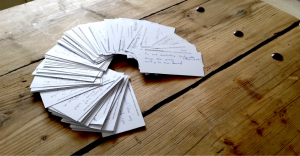Since Paul’s Vlog is about success in various fields, and since I’m a speaker – I thought it might be worthwhile to disclose how I’ve constructed presentations throughout my professional speaking career.
Hand Crafting a Presentation
While the old quip that, “people would rather die, than give a presentation” is exaggerated (slightly), it’s obviously true that most people don’t enjoy standing in the limelight.
Our reluctance to ‘stand and deliver’, is based on either the struggle involved in deciding what to present, or the physical act of standing on stage and speaking into the microphone – or possibly a petrifying combination of both.
Overcoming the fear of standing on stage is a difficult, and time-consuming task. It requires both control over our emotions, and our physiological responses to the situation initiating the fear. This requires a lot of practice. For some, the ‘stage fright’ aspect proves insurmountable. Thankfully, terminal cases of stage fright are an exceedingly rare medical condition.
On the other hand, overcoming the ‘struggle of preparation’ is significantly less difficult. We can turn that task into an almost robotic, automated process – with little thought required. Well, that would be mostly true, if not for the very, very first step.
Step 1: What does the audience walk away with, after we sit back down?
Our first possible fear is that we have nothing to say. A fear that we could negate, if we just accepted the fact that the person who invited us to speak, believes we have something important to say. Don’t contradict them.
Their perception that we add value to the stage, presents us with an opportunity to answer the initial question. Ask the person who wanted us to speak – what message they wish us to present to their audience. If we agree to present that message, then we’ve cleared the first step – if not? We don’t have to speak. In either case we’ve solved our problem.
It’s possible that we somehow find ourselves scheduled to be on stage with no clear direction, and we must decide for ourselves what our key points will be. When that happens, the best advice is keep it simple.
Keep the number of key points we wish to communicate to three, or even less, for a 60 minute talk.
Our tendency, because it is far easier, is to replace quality with quantity. When a microphone is placed into our sweaty, nervous hands – we want to tell them everything rapidly (Sometimes called ‘babbling’), rather than telling them something of value, slowly.
Until we can distill our answer to, “What does the audience walk away with, after we sit back down?” to twenty words or less? We’re not ready to proceed with our preparation, never mind being ready to get on stage. Those 20 words become our Holy Grail.
Step 2: The Mental Data Dump
The first step provides us with where we want to be when we finish speaking, this step requires a physical inventory of everything we believe is relevant to that destination. Grab hold of a deck, possibly two, of 3×5 cards and a bold marker or three, and start transferring all we could possibly say on our chosen topic to those cards.
Everything. Trivial, mundane, obscure, almost irrelevant (but not quiet), important, significant and especially the obvious. Everything goes onto an idea-card. No thinking – just a mental purge of information.
Step 3: Seeking flow
Spread all the idea-cards out in front of us. Which idea-card in front of us is where we’d like to begin? Which one is where we’d like to end? This should, hopefully be easy to do. The 20-word answer in step one, should strongly suggest what we should say at the end. The starting point might be more difficult. If necessary? Select multiple possible start points, the next step will start to point to a viable way to start.
Step 4: Creating flow
Place our starting idea-card to our far left – place our ending idea-card to our far right. Our mission, should we choose to accept it? Is to create a natural flow of idea-cards from start to end, one at a time. The keyword being ‘natural’.
Here’s how we do that. Go to the left most idea-card in our ‘flow’. What could we say naturally to communicate that single idea? Write that on the back of the idea-card.
Now -and this is the key step in this entire process- of all the idea-cards remaining? Which one flows naturally from what we’ve just written down?
If no idea-card is the obvious next card? Then find the next idea-card we think is most important to address at this point in the flow and create a segue into that idea-card.
Another option for us at this point is to take a step back in the process and re-evaluate the last idea-card in the flow and determine if there’s another idea-card that will allow us to better advance the presentation towards the end. This is the same process we’ll use if we were in the situation when we could not decide on an obvious place to start. We’d try multiple starting places and see which results in a successful series of stepping stones to the end.
Step 5: Finalizing flow
Once we have a series of idea-cards from start to end, we’re done. Almost.
We must determine how long our talk take to present and compare that to how long we’re scheduled to speak and adjust to fit.
If our talk takes less time than the amount we’ve been given? This is a relatively minor problem. We can speak slower – an option seldom seen, or we can revisit our flow and see where it might make sense to include additional idea-cards, never losing sight of the need to maintain the natural flow of the presentation.
If our talk takes more time than the amount we’ve been given? Then talking fast is never an option. At the very least? Speaking fast interferes with good breathing – which aggravates stress levels and increases stage fright. In addition? It communicates to the audience that we’re nervous, because we’re ill prepared, we lack confident in our own competence, and therefore maybe they shouldn’t be paying full attention to what we’re saying – which makes us nervous – positive feedback loop, and Boom!
If the talk we’ve prepared is too long? That’s a good thing. It means we have more to say than time to say it in – that’s far far better than the alternative.
The only solution? Go back to the idea-cards we’ve selected – and remove enough of them to reduce the length. While ‘painful’, it’s necessary to drop idea-cards and restructure the talk.
Admittedly, putting a talk together is far easier than giving it, but a well-crafted talk in our head, goes a long way to quietening the butterflies in our belly.
You can contact Peter at [email protected] and if you would like to browse his archive of webinars, head to www.technobility.online “.
To watch our listen to Peter’s podcast, go to: https://isintosuccess.com/podcasts/




